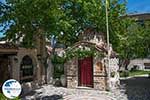Megali Panagia - Halkidiki (Greece)
Megali Panagia. Megali Panagia is a large traditional village in the prefecture of Halkidiki in Northern Greece. It is located between the peninsulas of Agion Oros (Mount Athos) and Sithonia. It lies about 12 kilometers (7.5 mi) from the village Arnaia and has about 3,000 inhabitants.
In recent years, Megali Panagia, the "Great Holy Mother," has developed rapidly in tourism, largely due to agricultural tourism. Megali Panagia offers all kinds of facilities to young people who, as a result, often remain in their native village rather than move away for employment.
Megali Panagia is located on the mountain Chtikela, in the middle of a beautiful green area, 80 kilometers (50 mi) east of Thessaloniki. The villagers are typically employed in the metal industry, the timber industry and farming. The village houses have a characteristic architectural style. Streets are paved with stone, a typical style you will see again and again in the prefecture Halkidiki and the whole district Macedonia.
Many religious travelers visit this village. In Megali Panagia are three major churches. The main church is the Church of the Holy Mother also called Panagiouda (or Panagouda), built in the 11th century. According to legend, this church, two kilometers (a little more than a mile) from Megali Panagia, is built on the spot where an icon of the Holy Mother was unearthed after a woman saw it three times in her dream. Other important churches are those of Agios Vasilios and the church of "Megali Panagia" which was built in 1863. Megali Panagia was formerly named Revenikia and is one of the oldest villages in the region. In ancient documents found in the monasteries of Agion Oros (Mount Athos), it is written that this village existed in the 10th century.
Text: Yorgos and Wendy Nikolidakis - Edited by Katrina Butzer
Photo Gallery Halkidiki - Photos of Halkidiki
Weather forecast Megali Panagia (Halkidiki)













 Megali Panagia (GriekseGids.nl)
Megali Panagia (GriekseGids.nl) Megali Panagia (GriekseGids.be)
Megali Panagia (GriekseGids.be) Megali Panagia (JustGreece.com)
Megali Panagia (JustGreece.com)